Physical Address
304 North Cardinal St.
Dorchester Center, MA 02124
A start-up company, in any field, starts with an idea, an idea whose innovator thinks will be successful (make money, be needed and wanted) in the market place. For neuromodulation, these ideas usually are birthed by biomedical engineers with either a good eye and ear for business or a businessman with a good eye and ear for biomedical engineering. In any case, as we shall see in this chapter, many good ideas never come to commercialization and they don’t for many reasons. The successful “birth to end” business progresses to a successful “end game,” and the process must meet and beat certain stepping stones (the reasons) to win the adjective “successful.” According to Maria Bennett, CEO of SPR Therapeutics, the stepping stones to a successful start-up, as agreed upon generally by our other start-up CEOs, are:
The process starts with an idea for a technology, product, or therapy.
There must be a scientific foundation for the technology, product, or therapy.
This technology, product, or therapy must meet an unmet clinical need in a sizable and sustainable, validated market place.
The idea (intellectual property, IP) for this technology, product, or therapy must be protected through legal means, with a freedom to operate.
Establishing a sound financial base for furthering the process to commercialization
Once protection and a sound financial base has been established, clinical data, establishing a proof of principle, safety, and efficacy of the technology, product, or therapy, must be gathered.
Success or failure often rests on designing well–thought out regulatory strategies,
Compelling financials have to be established that not only include raising of funds adequate for the whole process, but also assuring reimbursement.
Finally, success often means building the right team to accomplish the foundations.
Each of the following perspectives are unique to the individuals discussing them; however, there are, as we shall see, commonalities to them all.
Jon J. Snyder
Neuros Medical, Inc.
With more than 25 years of sales, marketing, and operations experience in the medical device arena, my perspective on bringing new technologies to market is truly rooted in the training I received while at STERIS Corporation in Cleveland, Ohio, throughout the 1990s. STERIS was at the time a pioneering medical device company (developing a novel liquid chemical sterilization system to support the rise in heat-sensitive, minimally invasive, surgical devices) with a spirit of “how we can do things” versus “why we can’t.” This dedication to the mission has stuck with me throughout my career.
STERIS grew from $14 million in revenue when I joined to over $1 billion in the 8 years that I was with them; quite phenomenal growth, both organic, but also through acquisition. In 2000, I left the marketing of capital and consumable medical devices at STERIS to join Cyberonics, entering the world of an implantable, prescribed neuromodulation therapy—quite a difference, but similar in many ways.
While at Cyberonics, in various customer-facing roles, such as national account management, regional sales management, and director of regional marketing, I like to tell folks that I “cut my teeth on neuromodulation and the effect it could have on patients, family members and caregivers.” Their Vagus Nerve Stimulation (VNS) Therapy for patients had a profound effect. Seeing before and after images of patients who seemed medicated, lost, and displaying the effects of drop-attack seizures, to smiling, bright-eyed, engaged people, truly showed me the positive results of the therapy. Many patients had a significant decrease in the number of seizures, and also a real decrease in antiepileptic medication use, which greatly improved their quality of life (QOL). Being engaged in the commercialization process via marketing, sales, and national account management provided for me an in-depth exposure of creating awareness for the therapy, through prescribing physicians, clinical support staff, patient support groups, and national/regional symposia, as very effective strategies to grow the acceptance of the therapy. As a result, the VNS business at Cyberonics grew to over $300 million annual revenue, based only on one indication. I felt that neurostimulation presented strong opportunities and applications based on my experiences at Cyberonics.
After I left Cyberonics, I was the marketing lead at several other companies, both large and small, however, I felt that the timing was right to lead my own endeavor. I had moved to Chicago to join a large medical device company, when a discussion with a former colleague of mine pointed me to my hometown of Cleveland, Ohio, and BioEnterprise, a business formation, recruitment, and acceleration initiative, designed to grow healthcare companies and commercialize bioscience technologies, who was adding their first CEO in Residence. The opportunity aligned perfectly.
I joined BioEnterprise in 2008. My role as CEO in Residence was to scout, evaluate, and perform due diligence on technology in the neurostimulation space, establish the vision for the business, form the Company, and lead the initiative. What better time to put a prerevenue neurostimulation company together than 2008 during the Great Recession!
I reviewed two dozen neurostimulation technologies, some in the Cleveland area at institutions such as Case Western Reserve University (CWRU), the Cleveland Clinic, and other research institutions throughout the world. The clinical applications that I reviewed ranged widely as well, from chronic pain, sleep apnea, and wound therapy, to stroke rehabilitation and epilepsy. I conducted a thorough due diligence effort during this time, looking at the technologies, relevant markets, competition, intellectual property, inventors, and funding requirements for each technology reviewed, producing a stack ranking. The more I learned, the more the ranking was adjusted. Finally, after an exhaustive effort, I was ready to put a stake in the ground and move forward with the technology that would become Neuros—high frequency, electrical nerve block.
The inventors of high frequency electrical nerve block, Drs. Kevin Kilgore and Niloy Bhadra of CWRU, had performed solid preclinical research, confirming the effect of the technology and discerning the mechanisms of how they were able to block nerve action potentials. Their initial focus was on motor applications such as spasticity, however when we reviewed the technology, we thought it had the potential of blocking pain.
Again, keep in mind that this was 2008/2009, the time of the Great Recession. Not many companies were getting off the ground and the potential for funding new entrepreneurial projects was very challenging. Fortunately, in Ohio, we have the Ohio Third Frontier, a state government initiative that supports organizations such as BioEnterprise and also regional funders, including JumpStart, and organized funds/angel funds in the State of Ohio. As a result, we were able to raise nearly $2 million in 2009 from Ohio-based investors through determination, persistence, and belief in the opportunity that our technology presented. This funding enabled us to establish our company, hire our CSO, Dr. Zi-Ping Fang (actually bring him back to balmy Cleveland, Ohio, from Silicon Valley!), and move forward to execute our feasibility study.
We also saw strong alignment with the Department of Defense (DOD) and military applications of our technology, due to our initial clinical focus of postamputation pain (phantom limb, stump pain). We augmented the $2 million in 2009 with additional grant funding from the DOD and the US Army to support our efforts in the following years.
Neuros’ initial targeted market, postamputation pain, is very much underserved. 2 million amputees present in the United States, with nearly 200,000 amputees added annually. Due to the rise in diabetes mellitus (DM) and peripheral vascular disease (PVD), these numbers will continue to grow. The projected US market of patients that suffer from chronic postamputation pain who are refractory to current treatments is nearly 1 million in the US. This number, ironically, is very similar to the market size estimates for VNS therapy for epilepsy. The therapy has potential use for other chronic pain applications such as chronic postsurgical pain, occipital neuralgia/migraine, to name a few with additional study, as well. The therapy also utilizes a very simple, well accepted and clean screening tool of lidocaine injection. If a patient responds to the lidocaine with significant pain reduction, theoretically, they should be a responder to our Altius High Frequency Nerve Block. See Figs. 140.1–140.3 .
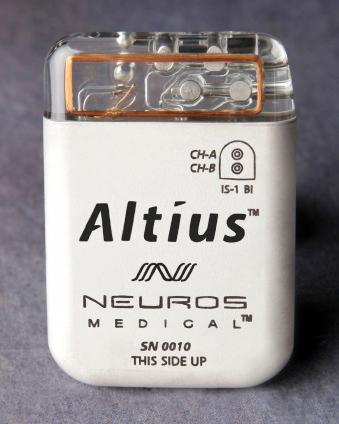
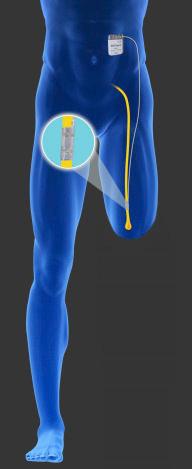
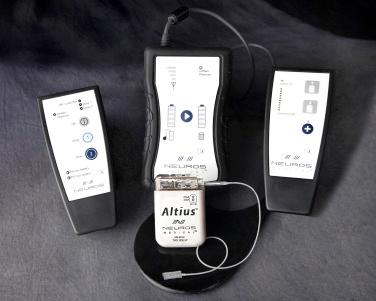
However, being first to market, developing the market, and validating the market is not only an opportunity, but a challenge. Spinal Cord Stimulation (SCS), for example, a $1.6 billion US annual revenue market with approximately 10% market penetration, is easy to compare to. The first SCS system, however, most likely met with the same market challenges of presenting the market opportunity, as I would expect VNS, Deep Brain Stimulation (DBS), and Obstructive Sleep Apnea applications did as well.
When we commenced our initial activities as Neuros, we wanted to get into first-in-man, as soon as possible, which is a bit contrary to other neurostimulation therapies. Many hire several engineers and develop an elegant device without any clinical activity. We felt that we couldn’t move forward to that step until we confirmed that the therapy was safe, would work in reducing patient’s pain, and was tolerable to the patient (proof of principle). We also needed to understand when the device should be used for the planned indication. Executing an elegant implantable device, prior to doing so, would have greatly reduced our trajectory. Fortunately, the first-in-man provided these understandings.
In 2011, upon the completion of the first-generation device, we completed our first-in-man study of five patients, the first time that the therapy had been applied in humans. What we found was significant and promising in the short term. Four of the five patients had significant pain reduction. The therapy was also very tolerable and didn’t require the device to be on 24 h a day, unlike conventional/traditional SCS devices. These key learned understandings were very important and foundational for electrical nerve block therapy and would then translate into the product development of our go-to-market device, Altius. It was also very impactful for us to see the pain reduction of the therapy in our patients, first hand.
We executed our first-in-man study at the Ohio Pain Clinic, under Dr. Amol Soin’s direction, in Dayton, Ohio. Dayton is the hometown of the Wright Brothers, and seeing the significant impact of our therapy in reducing the patient’s pain level and their anecdotal feedback of “being able to sleep throughout the night; first time since my amputation” made us feel that we were witnessing something monumental such as the Wright Brother’s first flight at Kitty Hawk, North Carolina.
The completely implanted system, Altius, was developed in parallel to our long-term pilot study, performed under Investigational Device Exemption 1
1 “An investigational device exemption (IDE) allows an investigational device (i.e., a device that is the subject of a clinical study) to be used in order to collect safety and effectiveness data, required to support a premarket approval (PMA) application or a premarket notification [510(k)] submission to the US Food and Drug Administration (FDA).” Taken from the Internet: https://www.google.com/#q=what+is+an+investigational+device+exemption& ∗.
(IDE). Upon completion of Altius, we received IDE approval to convert the pilot study patients over to the implanted generator, of which patients continue to use the therapy today. These patients report consistent, durable pain reduction, as well as significant narcotic pain medication reduction.
After the first round of funding in 2009, we raised additional funds in the following years. Being a prerevenue, neurostimulation/medical device company, you are always fundraising to support clinical, research, and development efforts. The funding environment continues to be challenging, with many venture capital firms unable to raise new funds due to a lack of their portfolio companies being acquired by larger companies. When their portfolio companies are acquired, they usually produce returns on investment for the venture capitalists. Without the returns, it is difficult to raise new funds for investors to invest into, and so the pool of available capital is reduced.
The venture capital industry’s prediction that there would be significant reduction in venture capital was correct, with now only one quarter of all VCs investing in medical devices. The lack of exits or IPOs is largely due to heavier governmental regulation in offering IPOs prior to having revenue, but also the fact that strategic partners are waiting longer to acquire new technologies. The days of executing a 10 patient, one-week study, and then exiting or selling to a strategic partner are long gone, as the development and commercialization risks still present themselves. Larger organizations, such as industry leaders, are now looking for technologies to be nearly completely derisked so that they can plug the therapy into their own sales and marketing organizations, as soon as possible, in order to show growth with the new therapy or technology.
This challenging environment has resulted in needing to raise more funds for small start-up companies than originally planned, and as a result, has lengthened the process of crossing the goal line, the “end game.” The key for all is to remember that good therapies that continue to show efficacy and safety will still be good investment opportunities.
We continue to develop and execute our clinical plan, with the initiation of our pivotal study, consisting of 100 patients at 15 centers. At the time of this writing, we have successfully completed the initial interim analysis of the first 20 patients. We have the drive to complete the journey, to get the therapy over the goal line, so that we can obtain US Food and Drug Administraion (FDA) approval and be able to see this therapy in the hands of more and more patients suffering from chronic pain.
Anthony Arnold and Yaakov Levine
SetPoint Medical Inc.
Key drivers of any successful start-up are first ensuring there is a demand for the therapy, funding, and agility. The demand for neuromodulation therapies continues to increase as scientific discoveries are made and technologies advance. Neuromodulation or bioelectronic medicine (neuromodulation for disease management) companies take upwards of 7 years to begin generating revenue and a decade or more to become profitable. This lengthy time horizon is not compatible with the investment expectations and needs of most venture investors, creating a very challenging funding environment for any new neuromodulation company.
Gaining early funding has become much more difficult due to the incompatibility of the timeframe. Most venture investors seek a return in three to 6 years and are looking for companies that are either close to an exit event or very close to producing revenue. As a result, new neuromodulation companies will face significant challenges securing the capital necessary to build a sufficient critical mass to enable a robust product development program.
Academic-Industry partnerships can serve as incubator hubs to catalyze innovation and early product development. Through their access to lab facilities, patients, and clinicians, academic institutions can help provide early customer insights to shape product strategy and funding discussions.
Engineers are often tempted to develop a “cool” device or technology and then search for a profitable application of the technology. SetPoint was fortunate to be able to develop a needs-based solution. Years of advanced clinical research and the guidance of scientists, rheumatologists, and neurosurgeons allowed SetPoint’s technical team to focus on developing a neuromodulation device, today known as a bioelectronic medicine platform, custom tailored to the needs of the patient and the treating physicians. Letting the needs of the users inform product design leads to better products and, hopefully, better outcomes. SetPoint was fortunate to have been incubated out of the Feinstein Institute for Medical Research and had both intellectual property (IP) and strong preclinical data before securing venture capital (VC) funding.
Another key driver to successful fundraising is efficient and agile milestone achievement. Investors prefer to see substantial data, including human data, before funding a development effort of tens of millions of dollars for the development a device. SetPoint took a unique and innovative approach to establish proof of concept very early by generating human data with a commercially available proxy device in order to secure a $30 million Series C funding round that enabled the initiation of product development. This funding supported hiring a team of eight to ten engineers and quality team members to design the product and concurrently develop and implement a robust quality management system that meets the standards, spelled out in 21CFR part 820 of the Federal Register.
To be successful, a medical device company must have capital, capital, and more capital that is connected to a group of experienced and patient investors. SetPoint has a stable of excellent VC and strategic investors including GSK’s Action Potential fund, Boston Scientific, and Medtronic that have helped secure our future. One of the highest priorities for the management team and specifically for the CEO is to ensure that the company always has the funds necessary to sustain ongoing operations. As a result, fundraising activities are a frequent and necessary part of the job for an early stage company.
Agility is another key determinant of success. Small device companies often face challenges in getting medical device suppliers and manufacturers to deal with them. The medical device manufacturing industry, at least for neuromodulation devices, is composed of relatively few companies that cater to and seek the business of one of the five or six major devices manufacturers. Small companies can’t afford to develop the capabilities to manufacture a neuromodulation device in-house and a major supplier can generate a better return, focusing their efforts on securing and maintaining business from Medtronic, Boston Scientific, Cochlear Corporation, or one of the other major producers, rather than investing in a more risky and long-term development program with a start-up. Even with the best relationship management, it is sometimes difficult to procure raw materials or process support in the aggressive timeline that is needed by small companies.
The regulatory and safety challenges to ensure the delivery of a safe and effective neuromodulation device are daunting and can easily impact development progress. Regulatory bodies require certain tests to be completed prior to initiating a clinical trial, and further testing is needed prior to commercialization of the device. For example, most neuromodulation devices would require mechanical, electrical, and software testing. If the device is part of a system, then system testing is required in addition to component level testing. Hundreds of tests that ultimately consume thousands of man hours and millions of dollars are often underestimated.
Start-up companies are often founded with IP-owned outright or licensed, some in vivo or in silico data, but few capital resources. Two important reasons to quickly generate initial or additional preclinical data are to establish feasibility to enable investors to fund early development, as well as to start defining the parameter space in animal models from which to build therapy-specific, design requirements into the neuromodulation device. These are important in new areas of neuromodulation, such as bioelectronic medicine, where there is a paucity of predicate devices. However, the lack of capital precludes the acquisition of expensive equipment and development of laboratories and infrastructure. There are several options that can be explored.
One option is to provide funding grants to academic laboratories. Funding an academic to complete a study on the company’s behalf is often the least expensive route to feasibility studies. The data is acquired by a group with experience in the field and with established protocols. Study design, as well as final interpretation of the data, is performed by an acknowledged expert in the field. However, ownership issues, surrounding IP of discoveries that emerge from these projects can be complicated. In addition, the sponsor will often lose some control over publication timing and content. There may be concern over the priority of an external project within the work-flow of an academic lab and the quality of reports generated may not meet the standards of a contract research organization.
A second option is to hire a contract research organization to run studies. A contract research organization is a more expensive option than an academic grant, but addresses many of the negatives of academic laboratories. The IP can be wholly owned by the company. There are generally no conflicts surrounding results publication, which is at the sole discretion of the sponsor. The ability of these companies to quickly adapt a new experimental design to their standard protocols can enable rapid execution. However, there are downsides to early studies, carried out by independent technicians who do not generally make observations beyond the prestated endpoints. These include a decreased likelihood of noting unexpected, hypothesis-driving observations, and lessened ability to respond to or with deviations and adaptations.
A third option is to lease incubator space. A company may address several of the deficiencies of both funding academic laboratories and contract research organizations by leasing space within a biotech incubator or research facility. This avenue can enable complete control over IP, prioritization, and timelines, while enabling access to capital equipment and use of a vivarium. Cost structures vary, but a standard lease will entail rent per square foot plus cost of core facilities on a per-use basis. While allowing the greatest flexibility, leasing incubator lab space is expensive due to the earlier-mentioned direct costs plus full-time employees to staff the facility.
In the case of SetPoint Medical, abundant preclinical evidence, surrounding our mechanism of action existed in the published literature; however, it consisted mainly of neurostimulation in only acute settings and pharmacological analogs of stimulation. We needed to bridge the evidence gap to demonstrate therapy in rodent models of chronic disease using repeated stimulations. In addition, effort surrounding pulse train design needed to be performed.
SetPoint Medical used a combination of these approaches, beginning with renting space within a research institute. Work performed in this setting led to the design of effective miniature electrodes for rodents and internal knowledge regarding optimization of various stimulation parameters in acute models of inflammation. SetPoint Medical then hired a contract research organization that specialized in the rodent model of rheumatoid arthritis (collagen-induced arthritis) (RA) to prove the principle of treating chronic inflammation with VNS, using this internally developed know-how. The successful results of that study increased both investor and investigator confidence in a pilot clinical study of VNS to treat RA as well as providing certain requirements for the device development team. SetPoint continues to utilize a combination of these options to more expediently advance our research goals.
Maria Bennett
SPR Therapeutics
The field of neuromodulation has markedly evolved over the past decade, with an explosion of progress taking place in just the past 5 years. Ideas from the intersection of clinicians, scientists, engineers, and entrepreneurs working together have come to fruition with Jetson-like inventive therapies, designed to provide meaningful clinical benefit, receiving FDA clearance and hitting the market. Neuromodulation offers numerous therapies that consists of noninvasive electrical stimulation devices to fully implantable devices. The market is suddenly flush with new technologies for target indications that include:
DBS: Parkinson’s disease, epilepsy, and depression
SCS: pain
VNS: epilepsy, depression, inflammation, and obesity
Peripheral Nerve Stimulation (PNS): chronic and acute pain, migraine, incontinence, foot drop, and sleep apnea
Gastric stimulation: obesity and drug refractory nausea
Implantable drug pumps: pain and spasticity
Perhaps the field within neuromodulation that has emerged most drastically is PNS. For years, clinicians and industry have recognized that developing neurostimulation therapies in the periphery has tremendous opportunity and potential for treating a variety of disorders. Having the right PNS technology to deliver electrical pulses to specific peripheral nerves has the ability to trigger a reaction upstream in the spinal cord and ultimately in the brain to remap or intersect sensory and/or motor pathways that lead to enhanced symptom relief and greater therapeutic benefit.
I have studied PNS for more than 20 years, first as a graduate student at CWRU and now as an entrepreneur and scientist at SPR Therapeutics. In 2010, I founded SPR Therapeutics to further explore the effectiveness and benefits of PNS in hopes of developing, creating, and bringing to market a nonsurgical, least-invasive, nonnarcotic therapy for people suffering from acute and chronic pain.
Prior to launching SPR, our team defined building blocks necessary to lay the foundation for a successful neuromodulation company. The primary attributes or building blocks include:
an idea for a technology, product, or therapy;
there is unmet clinical need for the for the technology, product, or therapy in a sizable validated market;
having or building a scientific foundation for the technology, product, or therapy;
assuring that there is protection of the IP (for the technology, product, or therapy) with a freedom to operate;
establishing clinical data;
designing regulatory strategies;
compelling financials (establishing a financial base and assuring reimbursement);
building the right team to accomplish the foundations.
Through diligent vetting of these attributes, we defined what assets we possessed and the strategies to create the value and assets in the areas where there were gaps. Firstly, it was important to validate the unmet need and clinical feasibility through market research and clinical studies. This research confirmed the opportunity for our idea, and SPR was launched.
In the field of pain management, it has been well accepted by physicians, patients, payers, and big business that neurostimulation treats pain effectively. Traditionally, it has been done with pace-maker-like devices that are implanted surgically under general anesthesia and intended to be used long-term. SPR had the novel idea of taking a very effective therapy (PNS) and making it patient, payer and physician friendly. We developed the SPRINT PNS System. SPRINT is a technology that significantly reduces the cost and invasiveness of PNS, given that it does not require surgery or a permanent implant; rather, it can be placed by a physician in an outpatient setting after which it is completely removed at the end of the several-week treatment period.
The SPRINT System includes a threadlike, coiled wire, or lead, and a matchbox-sized wearable stimulator, about the weight of four quarters. The lead is placed percutaneously, or through the skin, via a fine needle and connects externally to the wearable stimulator. The stimulator delivers electrical stimulation through the lead, which activates peripheral nerves to achieve pain relief. It is designed to operate effectively in moving limbs and joints, making the therapy compatible with everyday life. SPRINT is unique in that it allows lead placement as far as 2–3 cm from the targeted nerve. This makes the lead placement procedure safer and more forgiving for physicians and gives them the distinct ability to preferentially stimulate targeted fibers within the nerve to maximize pain relief. See Figs. 140.4–140.6 .
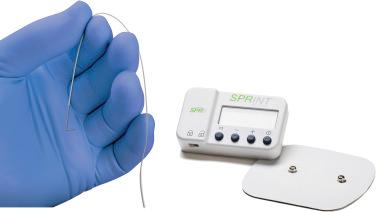
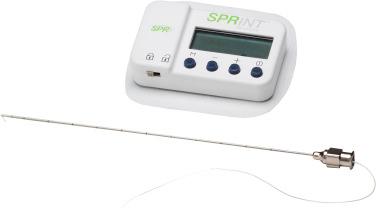
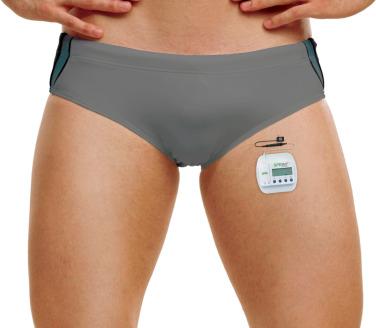
Become a Clinical Tree membership for Full access and enjoy Unlimited articles
If you are a member. Log in here